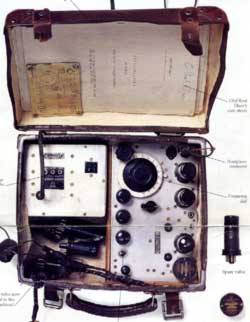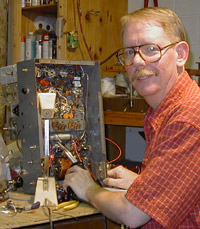
CW, morse code, and my Paraset project
I learned the code in 1973 by listening to a "learn-the-code" record. Over and over and over ... In those days the Novice license was the beginner's target, and 5 words-per-minute was the testing requirement. I soon passed the exam and was off to the races. My father could sometimes be talked into providing 50% "matching grant"money for worthy causes, and my first ham radio qualified. Dad must have realized that this might just lead to some skill and ... self-suficiency! At the purchase price of $50, I had a VFO-controlled 2 watt CW tranceiver - a Ten Tec PM2B. Mine was apparently one of just a few models that only had one band - 80 meters.
Many contacts between 3.700 and 3.750 ensued, and my CW skill eventually grew enough to barely pass the 13 wpm requirement for the General class license. The peak of my ability was at age 15 when I was reliably copying W1AW code practice at 20 wpm.
My buddy across town in Decatur, IL - Steve [now K9CZ] spent much more time than I did working cw, and always seemed to copy at about double my speed. He remains the CW guru. In a weak moment he sold me his 1942 J-36 semiautomatic key ("bug") -pictured in the banner above for $10.
Over the years I've mainly operated voice and data modes, but have recently become reacquainted with cw. Until the advent of certain below-the-noise digital modes, it was the most robust means for weak signal reception. It has a certain original charm, an unmatched simplicity, and its historical roots beckon for exploration by those revisiting their childhood through buying old ham gear. You don't know anybody doing that do you? So I've been operating CW again.
Then I discovered the Paraset. Having grown up with James Bond and World War II movies, real spy radios must be seen. Better yet, replicas must be built. There is an active Yahoo group of Paraset constructors and operators, generally hams, many from formerly Nazi occupied countries, referred to in group discussions - as Agents. These folks have gone to great lengths to research the Paraset, locate and obtain parts, and construct a replica.
Photo of my Paraset ... so farThe units were manufactured by the British during the war, and consisted of a three-tube receiver-transmitter ("R/T"), to be used for clandestine wireless telegraphy ("W/T"). One 6V6 tube formed a crystal oscillator-transmitter producing about 5 watts output in the range of 3-8 Megahertz ("Megacycles"). The receiver was a tuneable regenerative unit with a third tube serving as an audio amplifier to power headphones.

Many hundreds were made, but only a few originals remain. Replica construction is popular, with the goal of original authenticity. This is done to varying degrees, depending upon the constructor's skill, resources, and patience - as most of the real parts still exist but can be very hard to find. As an example, two flavors of original knob styles seem to have been made, with neither available today - so the English members of the group were kind enough to have a mold made from an original, and commission another manufacturing run - so I now have nearly all my parts. I hope my build will at least be externally completely authentic.
On the Yahoo group, various "Agents" will occasionally go on "missions" taking their Parasets to rural areas to operate the way a 1942 clandestine operator would have. Paraset to Paraset QSOs are also scheduled, as well as D-day QSO parties.
Using these spy radios during WWII was quite a risky endeavor, because the Germans were very adept at direction-finding ("D/F") and triangulating their source location. Key clicks produced by the transmitter could interfere with normal broadcast reception in the local area, and if that weren't enough, the receiver, being the regenerative type coupled it's own RF emissions to the antenna. These could also be DF'd. As a result, most of the WT operators were caught, and many were executed as spies. Many were also turned. Faced with the choice of a firing squad, or working for the Germans as a double-agent, there were many attempts to fool the British intelligence folks with their own agents sending messages prepared by the enemy. This was occasionally successful, and in the case of occupied Holland, Nazi efforts in this area virtually wiped out British espionage operations there for a period.
So the relatively low transmit power coupled to a hidden expedient wire antenna was not necessarily a bad thing, but transmissions still needed to be kept very brief - five minutes was the usual rule, as Nazi DF operations could generally locate covert transmitters within 10 to 15 minutes "Achtung! drei vier sechs funf KiloHertz" and the Reichssicherheits-hauptamt organization would direct multiple receive sites to DF 3.465 Megacycles simultaneously.
5 watts of cw would easily traverse the France - London, or Norway - Scotland path when voice communication would be hopeless - and the Brits' home stations typically used highly directional receive antennas - a four-element co-linear dipole array, or full-size rhombic optimized for each band and direction. Unlike the home station which typically used state-of-art National HRO receivers, the Paraset agent's receiver was lesser one-tube regenerative - but he (or she) had the benefit of tuning in to a 250 watt signal from England. And when propagation conditions were poor, a 15,000 watt transmitter was available.

At left, restoration continues on my 1939 National NC-101X receiver. Also in line after my Paraset completion is a National SW-3 !
Anti-spam
mail: chris.scott[AT]wku.edu
W4NEQ.com
Our lady cw operator in the top banner was the QST cover girl in May 1942, when wartime required operator recruitment. Unable to locate a graphically-required southpaw "hamette," the editors hired a professional model. See the original cover here.
Back to W4NEQ Main Page